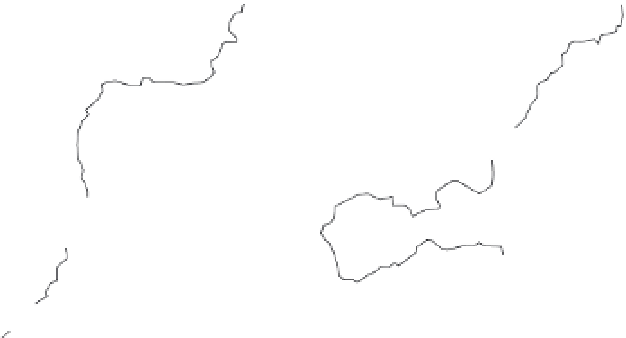Geoscience Reference
In-Depth Information
13
°
W
30
°
N
20
°
W
100 km
La Palma
Lanzarote
Tenerife
Fuerteventura
La Gomiera
Gran Canaria
Giant landslide <2 Ma
El Hierro
Debris flow < 2 Ma
27
°
N
Figure 7.9.
Giant landslides surrounding the Canary Islands (after Krastel
et al.
,
2001
and Carracedo
et al.
,
1999
).
was assumed to represent hummocky materials formed from a debris avalanche.
Differences in the amount of backscatter have also been used to identify the over-
lapping of debris avalanche deposits resulting from a variety of debris flows.
Side-scan sonar was also used successfully to determine and help date late
Quaternary slope instability on the Faeroe margin east of the British Isles. The
sonar images together with subbottom profilers and sediment core samples were
able to identify recurrent mass movements on the Faeroe margin and the Faeroes
slope of the Faeroe--Shetland channel. Sediment layers were separated through
theroughness of the topography and the texture of the sediment deposit (Kuij-
pers
et al
., 2001). Sediment echo sounding can also be used to create a profile of
theseabed and detect individual blocks and allow for estimates of their size. As
with side-scan sonar, the profile can also be used to estimate the extent of the
landslide. Both these methods are frequently used together to provide a more
complete picture of the nature of a deposit and its morphological characteristics
(Krastel
et al
., 2001).
By identifying the extent and size of submarine landslides these techniques
help to ascertain the frequency and magnitude of possible associated haz-
ards. Krastel
et al
.(2001)note that one giant landslide occurs on average every
125 000--170 000 years in the Canary Islands (Fig. 7. 10 ), but this must be regarded
as a minimum value. Four giant landslides have occurred since 200 000 years
BP on the flanks of El Hierro and Tenerife resulting in one landslide every
50 000 years. More frequent smaller events have probably occurred as well. These
landslides themselves represent a very serious hazard, especially if one were to
occur today. Large lateral blasts due to the explosion of hydrothermal or mag-
matic systems may also be associated with the slides. The tsunamis generated





































Search WWH ::

Custom Search